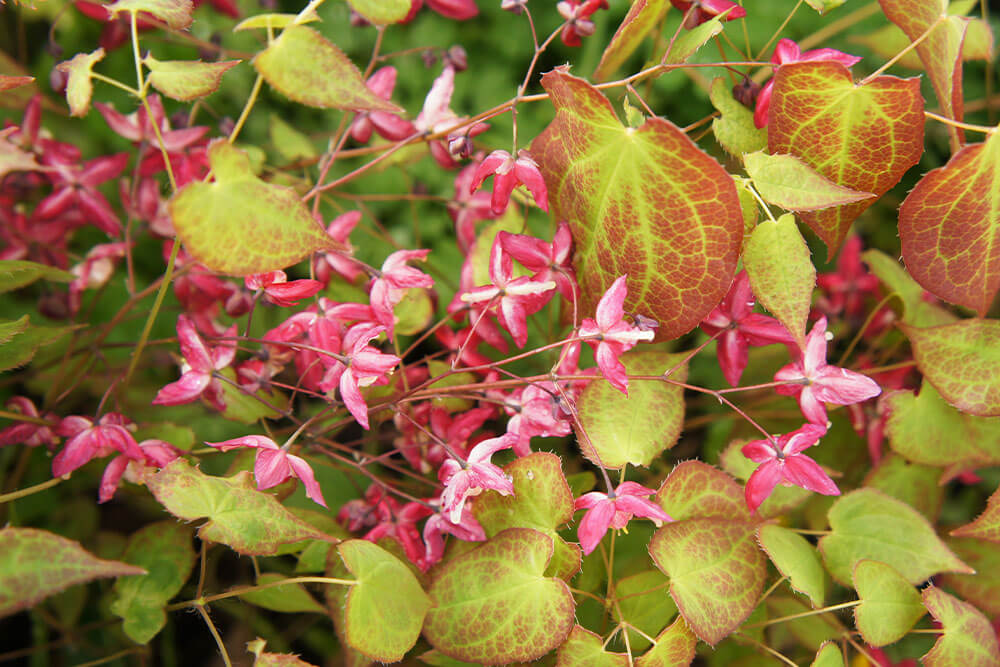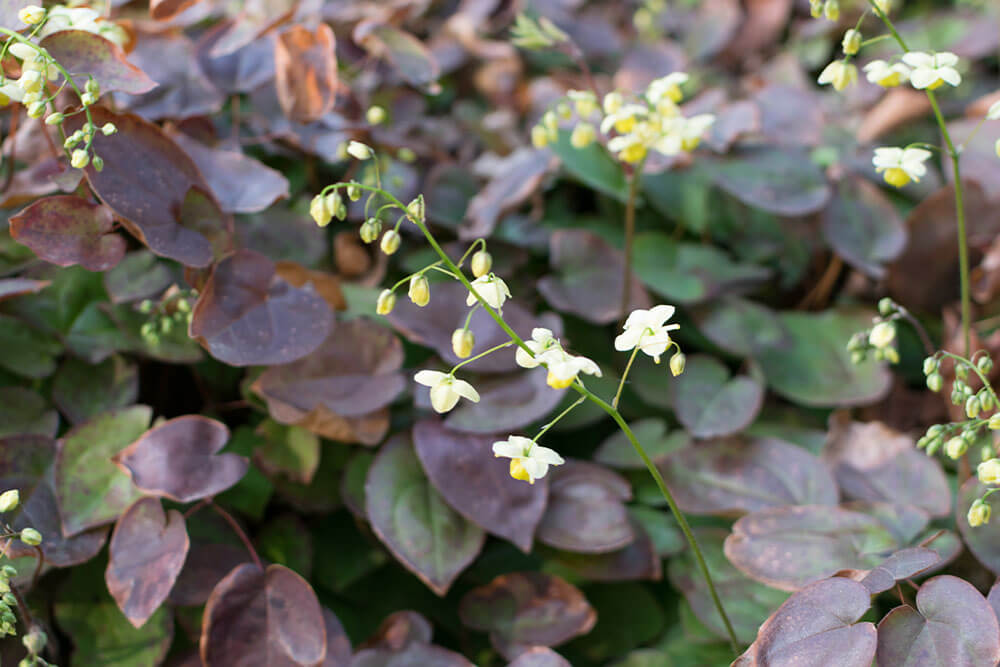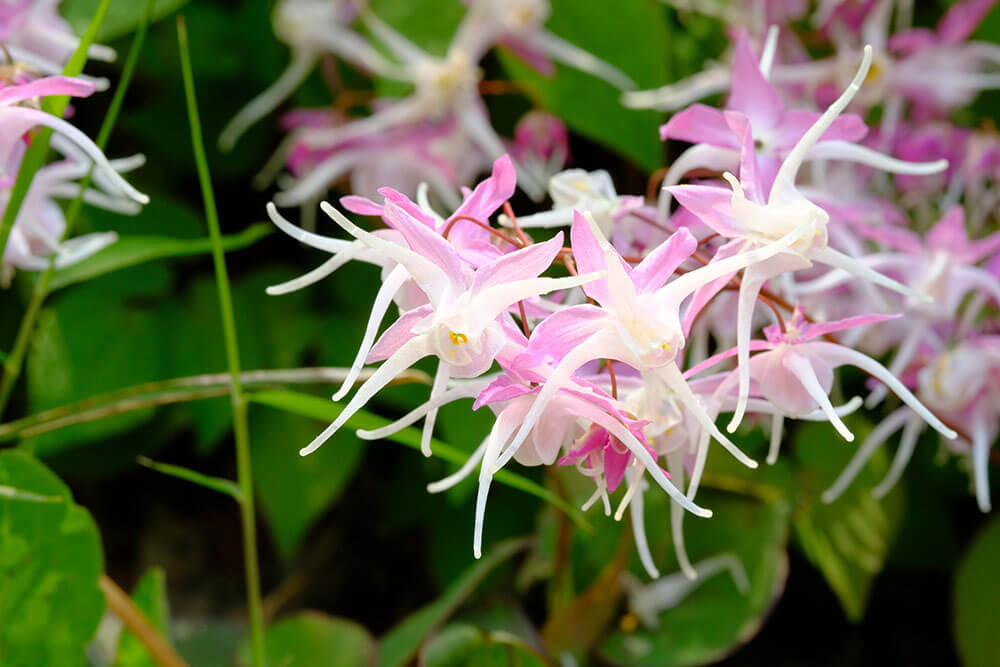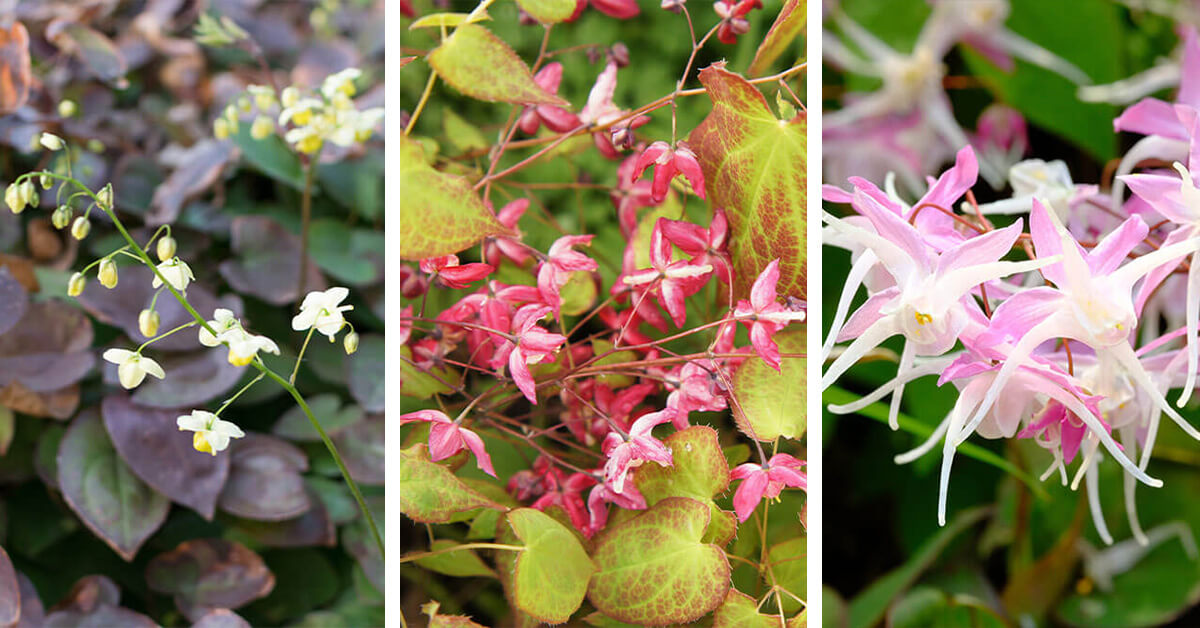Think of wall-to-wall carpeting outdoors, only it’s made of flowers. Epimedium spreads colors throughout your landscape in spring. It slowly covers barren areas, making it an excellent ground cover.
What is Epimedium?
This genus of plants had its beginnings in the woodlands of Asia and the Mediterranean. It likes a little shade, so it’s a perfect accent under trees. You can also use epimedium in rock gardens.
If you look at epimedium plants, their leaves have red markings and the shape of a heart (what’s not to love?!). The ground cover sends up leafless stems from which the dainty flowers bloom. From a short distance, they almost look like butterflies or orchids.
You have a wide range of colors from which to choose for planning your garden. Epimedium comes in pink, purple, red, white, and yellow. Certain species of epimedium are part of traditional Chinese medicine.
Key Takeaways
- You have your choice between red, pink, orange, yellow, purple, and white epimedium.
- The characterization for epimedium is as a carpeting perennial.
- Epimedium is not a great choice for houseplants. They need room. Their growth expands in healthy ways outdoors.
10 Exploratory Topics about Growing Epimedium
Monikers for Epimedium: Saying epimedium is quite a mouthful. So, you can call the plant barrenwort, bishop’s hat, fairy wings, or horny goat weed.
1. Types of Epimedium
Barrenwort is a charming perennial. They’re not fancy nor pompous. People love them for just that reason. Visualize a group of children playing merrily among the flowers. It’s rather nostalgic.
In the 1980s, Epimedium plants began transforming. We now have new species varieties, and there will be more additions as time goes on. Some of the fundamental changes include mottling, variegation, and leaves with serrate margins.
There are several types of bishop’s hats you may enjoy.
- Amber Queen: As the name implies, the yellow flowers have an amber tint. It flowers from April until June. It may look dainty, but it’s one tough plant. A slow grower.
- Fire Dragon: This epimedium has leaves tinted with silver and amber. That’s quite a backdrop for Fire Dragon’s star-shaped pink and yellow flowers. Slow spreading.
- Lilac Seedling: You’ll love the copper-tinted green leaves of the Lilac Seedling. They’re shaped like little arrows. As you might expect, the flowers are lilac. A fast grower.
- Lishihchenii: You cannot miss the large pink leaves of this plant during the spring. Mix in yellow and some green, and you have a stunning plant. They grow 4-6” annually.
- Pink Champagne: The foliage on this epimedium is russet-red. Over top, the breathtaking flowers are pink-red. Slow to establish.
- Wudang Star: The foliage on this plant looks a bit like spiny leather that develops raspberry-colored flecks after it blooms. This is what you might call a “cottage garden” plant.
For 150+ years (as of this writing), epimedium underwent hybridization. Keep your eyes open as more cultures develop. Many are incredibly resilient, growing where other plants cannot. Deep shade? No problem. Drought conditions? Also, no problem with an established plant.
2. When to plant Epimedium
Plant your epimedium early in the day before the sun gets hot. The best time to plant them is in spring, cool summer days, or fall. Position them in partial shade for the best blooms.
Propagate Epimedium: The best way to propagate epimedium is by division. Once it gets to the boundary of the allotted landscape space, divide it. Give the soil a light watering so you can slice through the fibrous roots, which are very dense. A sharp spade is a good choice of tools.

3. How to plant Epimedium
Look around your yard space for partial shade. Most epimediums prefer balanced light. Don’t expose it to the full light of day around noon. You also need well-drained soil. If your soil is dense, you can always remediate it with an aerator and organic mulch.
Look at the north side of the house for potential planting spots or in the shade of tall plants.
Important matters:
- pH of the soil should be between 5-7. Do a soil test for certainty.
- Avoid boggy spots and heavy soil.
- Sneak a bit of rotted leaves or compost into your plating holes, especially in rocky territory.
- Give your epimedium space to grow. Put them about a foot apart. Don’t worry that space fills up quickly as the ground cover grows.
- Watch new plantings. They are more thirsty than your established plants.
Miss or Mr?: While epimedium is not self-fertile, they have a remarkable trick up their stems. They’re hermaphroditic! Perhaps this is one reason healers in China used aerial parts to thwart impotence.
4. Growing Tips for Epimedium
It’s always nice to have a few tricks up your sleeve for keeping your plants happy. For epimedium, one gift that elicits a proverbial “woo hoos” is organic matter. It supports soil drainage while feeding the plant.
If you have an evergreen variety of epimedium, cut it back just as flower stems peek their heads up to say hello. In the fall, trim off old foliage. And rejoice in the epimedium’s flexibility. It grows well with trees, in rocky and dry soil, and in lower light.

The young epimedium plant, along with its leaves, is edible. They’re best soaked, boiled, and consumed as tea. Have your sugar bowl ready. The tannins in horny goat weed are very bitter.
5. Transplanting
People who planted epimedium around their yard may find it growing beyond the reasonable space given. By transplanting mature parts, you give the whole “colony” a better chance for vitality.
If you’re going to transplant, wait until early spring or late autumn the plant goes dormant. This timing decreases stress on your plant. The transplanted parts can establish roots before new growth begins. Just as you surveyed your property for initial planting, follow the same rules in terms of placement of the transplant.
Be gentle when digging up fairy wings. Stay a distance away from the stem. Loosen the soil around the plant, and lift it tidily out of the ground. If your epimedium has rhizomes, you can divide them during the transplant.
Remember to put the transplant into the ground at the same depth as before.
Epimedium belongs to the family Berberidaceae. So, Bishop’s Hat is related to Mahonia and Berberis. If you look at species like the Epimedium wushanense nova, the resemblance is unmistakable. Cool trivia fact: Heavenly Bamboo nestles in this family, too.
6. Landscaping
Landscapers love epimedium. But you don’t have to be a professional to appreciate this ground cover and use it effectively in your yard.
For example, provided the light and soil are right, you can add angel wings for dots of color where everything else is green. Or use it as a border adjacent to pathways. It will draw the eye where you want it to go.
If you’re looking for a plant for transitions between your garden and lawn, epimediums are it. When you have tons of tall greenery, this ground cover provides a different level. Consider your current lawn and the plans you have going forward.
Barrenwort creates harmony between other low-ground plants. Think hostas, ferns, and wild ginger. Should your lawn have issues with holding soil in place, the dense roots of epimedium help out. It won’t work well in large spaces because of its slow growth rate, but for smaller spots, it’s a cheap solution.
Two Types of Epimedium: In this family, you’ll find both deciduous and evergreen species. The vast majority are evergreen, retaining leaves throughout the winter. Deciduous cultivars like E. grandiflorum need no pruning. Their leaves fall before winter.
7. Pruning

Among most types of epimedium, pruning is an important part of maintenance. When done correctly, it improves your plant’s growth. It has the secondary benefit of helping with pest management.
Step one is looking over the plant. Find dead and damaged foliage. It’s not hard to spot them, being brown or shriveled against the other greenery. Use pruning shears and remove this foliage. This is also a good time to trim out lanky stems. So doing this gives the garden better airflow. Don’t rush. It’s important that you don’t cut into stems with new growth.
Clean up the yard waste. If you leave it, the area may become too moist. Keep fungus at an arm’s distance.
While it might be tempting to leave things alone as cold weather approaches. Don’t give in. Think of it as a haircut. The plant can focus energy on healthy growth.
8. Wintering
As an evergreen epimedium requires little winter care. Having said that, if you live in an area facing harsh winters, provide some protection for your plant. A frost blanket or burlap are both good choices.
You have an abundance of potential pairings with other shade perennials. Ideas include:
- Anemone
- Blue Cohosh
- Geranium
- Hostas
- Impatiens
- Jack in the Pulpit
- Leopard plant
- Mayapple
- Purple sprite
- Skeleton plant
- Widow flower
And many, many more.
9. Pests and Diseases
Slugs and rabbits like epimedium as a snack item. They rarely create lasting harm. Vine weevils and the mosaic virus are two different matters altogether. Vine weevils hatch in the roots, which then become the dinner table. Insecticide applications in May and June are good deterrents.
The mosaic virus manifests on the leaves with raised bubbles and spots. Some foliage may deform, and the plant’s growth can suffer. If you discover plants with the mosaic virus, remove them immediately, and don’t use that space until you can remediate the soil.
Aphids may appear. Just hit them with a thorough coat of neem oil on both sides of the leaf. Pick off slugs and snails first thing in the morning.
Seriously, your best defense against disease and pests is a good offense. Make sure the plant has proper drainage, sunlight, and air circulation. Get in the habit of checking all your plants for those three. It’s a sound cultural practice.
Field Guide to Epimedium: Epimedium leaves have the shape of a lopsided heart. They resemble begonias in this configuration. The flowers will burst forth from long scapes, clustered in little bundles. The blossoms face downward with folded-back petals.
10. Common Epimedium Problems
The most common problem with epimedium is they don’t like to share. These plants can be very invasive because they spread naturally. If there are other plants in the way, they better move over. If the epimedium gets out of your designated area, you may find it growing in your lawn. Thankfully, this ground cover grows slowly, making it easier to control.
As folklore has it, epimedium’s nickname came about thanks to observant goat herders. They observed their goats becoming rather, how shall we say,” active.” Hence, the amusing moniker.
10 Helps and Hints for Epimedium Care and Growth
Epimedium plants burst forward with color every spring. If you give them fertilizer at this time, they’ll blossom even more. Add the right soil, light, and water, and you have an impressive ground carpet. One of the best uses for epimedium is to fill empty spots in your landscape. They will gently grow and settle into the location, rounding everything out.
[wp-faq-schema title=”Frequently Asked Questions About Epimedium Care and Keeping” accordion=1]


